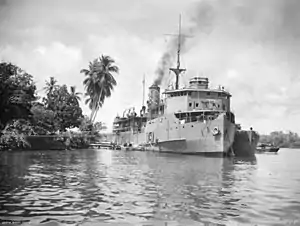 HMAS Ping Wo at Madang, Papua New Guinea on 31 October 1944 | |
| History | |
|---|---|
| Namesake | 平和 (Cantonese ping4 wo4), "equitable harmony" |
| Owner | Indo-China Steam Navigation Company |
| Builder | New Engineering & Ship Building, Shanghai |
| Launched | 1922 |
| Acquired | 1941 |
| Commissioned | 22 May 1942 |
| Decommissioned | 24 June 1946 |
| General characteristics | |
| Class and type | River steamer |
| Tonnage | 2,671 GRT |
| Length | 300 ft (91 m) |
| Beam | 48 ft (15 m) |
| Draught | 13.6 ft (4 m) |
| Propulsion | Triple expansion engines |
| Speed | 14 knots (26 km/h; 16 mph) |
| Complement | 50 |
| Armament |
|
HMAS Ping Wo (not to be confused with HMAS Whang Pu) was a 3,105 tons former Indo-Chinese river steamer that was commissioned into the Royal Australian Navy (RAN) during World War II. The Chinese name translates to "Equitable Harmony".[1] It was one of a group of vessels known as the "China Fleet" acquired by the RAN in similar circumstances.
Operational history
Built in 1922 for the Indo-China Steam Navigation Company, the vessel was initially requisitioned for service with the Royal Navy (RN) in December 1941 as a water carrier.[1]
After the fall of Singapore the vessel sailed to Batavia (now Jakarta) and with a mixed complement of RN and RAN reservists and civilian Chinese seamen, was engaged in the 62-day tow (at an average speed of three knots) of the disabled HMAS Vendetta from the Javan port of Tanjung Priok to Fremantle, Western Australia and subsequently part of the way to Melbourne to Albany. This tow was the longest ever involving an RAN warship.[2] Some of her crew had previously served on the British cargo liner Talthybius, which had been sunk at Singapore in an air raid.[3]
After this, Ping Wo was paid off by the RN on 19 May 1942 and then chartered and commissioned into the RAN on 22 May 1942.[4] As HMAS Ping Wo, the vessel sailed to the east coast of Australia and was initially used as a tender at the joint Australian-United States amphibious training centre at HMAS Assault, Port Stephens.[5] HMAS Ping Wo was later used as a stores ship and from January 1945 as a repair and works depot vessel in the New Guinea theatre of operations, winding up as the RAN administrative headquarters at Madang.
After the end of naval operations in New Guinea, HMAS Ping Wo was paid off and returned to her owners in Hong Kong on 24 June 1946.[4]
Post-war career
In September 1947, the vessel was sold to Hoong On Steam Navigation Co Ltd, Shanghai and renamed The On. In 1949, The On came under control of the new government of the People's Republic of China.
See also
Citations
- 1 2 "HMAS Ping Wo". Allied Chinese Ships WWII. Allied Chinese Ships Association. Archived from the original on 28 October 2003. Retrieved 18 July 2010.
- ↑ "ID number 128104". Australian War Memorial. Archived from the original on 10 September 2012. Retrieved 18 July 2010.
- ↑ Eagles, James. "Ping Wo's Golden Secret". Naval Historical Society of Australia. Retrieved 11 September 2011.
- 1 2 Gillett & Graham 1977, p. 255
- ↑ Mallett 2007, p. 121
References
- Bastock, John (1975). Australia's Ships of War. Sydney: Angus and Robertson.
- Gillett, Ross; Graham, Colin (1977). Warships of Australia. Adelaide, South Australia: Rigby. ISBN 0-7270-0472-7.
- Gillett, Ross (1983). Australian and New Zealand Warships 1914–1945. Sydney, New South Wales: Doubleday.
- Mallett, Ross (2007). "Together Again for the First Time: The Army, the RAN and Amphibious Warfare 1942–1945". In Stevens, David; Reeve, John (eds.). Sea Power Ashore and in the Air. Ultimo, New South Wales: Halstead Press. p. 121. ISBN 9781920831455. OCLC 271328006.
- Wildy, Merv (14 July 2003). "Allied Chinese Ships WWII". Archived from the original on 28 October 2003. Retrieved 24 October 2010.